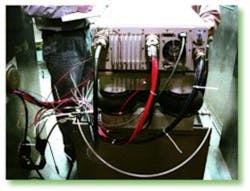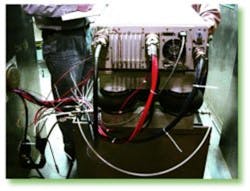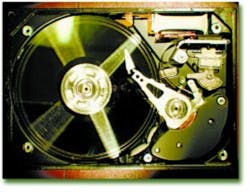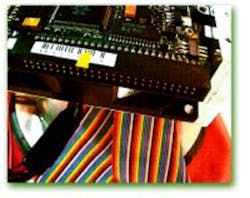Wrong Method
One of the most common mistakes to make with accelerated testing or any testing is using the wrong test. Given the myriad of testing options available and the reams of testing specifications that exist today, how do you know what testing process should be used for a given component or system? What information is needed, and what is the most efficient means of getting the desired results? What process for what part?
The key is the information goal—the information needed to validate a particular design feature or design level. For example, at the earliest design stages, the concept must be demonstrated to be feasible, while a product nearing production must exhibit a given level of confidence.
Gathering the information needed to validate the product at the different levels is the goal of the testing. By identifying the information goal and examining the purpose of different test methods, the right method can be selected. For example, here are two accelerated test methods and their respective goals.
- Failure Mode Verification Testing (FMVT®) uses as few as one prototype. This method establishes multiple design-inherent failure modes, ranks the failure modes, and estimates the potential for improvement in the design (design’s maturity).
- Highly accelerated life testing (HALT) uses a few samples to establish multiple design-inherent failure modes and the operating and destruct limits of a product.
These two accelerated methods are very similar but have a slight difference: one establishes the design’s maturity and potential for improvement while the other determines operating and destruct limits. Do you need to know how mature the design is and the potential for improvement so you can decide to iterate or produce it? Or do you need to know how close the operating and destruct limits of the product are to the required specifications for storage and operating limits? The answer to these types of questions should drive the choice of test method.
However, we engineers are a lot like children. If you give a child a hammer, everything will need pounding. If you give an engineer a new test method, everything will need that test method.
Wrong or Missing Stress Source
Most often, a product test is incorrectly accelerated by increasing a limited number of stress sources. In accelerated testing, a stress source is any external source that can damage the product. Vibration, temperature, chemicals, electrical, ultraviolet light, and mechanical loads are all damage sources.
Often times in developing an accelerated test, a product will be stressed based only on the most obvious sources of stress to the product. For example, a military uninterruptible power supply manufactured by Acumentrics recently was tested for durability and functionality by Entela Engineering and Testing Laboratories. The normal test requirements were electrical power and electrical load.
Far from minimizing the number of stress sources, when the test was planned, all that could damage the product were included: vibration, temperature, salt water, dust, and full load drop. The product survived and still was functional after undergoing the stress sources and combinations of stress.
However, several incidents were found that had nothing to do with the two original stress requirements but were caused by vibration, dust, or a combination of the two. This information, that otherwise would not be available, is being used to improve the already robust product.
In conducting an FMVT, it is recommended that a brainstorming session be conducted in which the question “What can break the product?” is answered in detail. The brainstorming session often can extend to stress sources that seem at first, to be ridiculous.
Thermal-nuclear explosion is not in most test plans. However, answering the question, “What can break the product?” forces the participants to think beyond what is expected and consider all sources of stress.
One of the items often used for a brainstorming session is a simple plastic hinge. The assignment is to identify at least 18 sources of stress for a plastic hinge. The only ridiculous stress source is the one not mentioned.
In a more controlled example, a product test was accelerated successfully using the FMVT method. The product was a rear-view mirror with self-dimming glass and a sophisticated compass circuit board that had undergone a design improvement. The manufacturer wanted to have the design change approved by the purchasing company as quickly as possible to save manufacturing costs.
Competitive testing between the old design and the new design was conducted using vibration, hot and cold temperature, and electrical load as stress sources. All of the stress sources were applied and increased. The results of the test clearly showed the new design to be far superior, and the manufacturer was given the green light to start saving money.
An extra set of the mirrors was provided to the testing lab for training purposes. The mirrors were retested with all the stress sources except temperature. Temperature was eliminated so the product could be run outside of the chamber to make it easier to train a large group.
The results of the second test were very interesting. The new design did not out-perform the old design. The failure modes found did not include those discovered in the first test that involved temperature or temperature combined with the other stress sources. Also, because some failure modes were not found, the product lasted longer under test, and other failure modes not relevant to the product were found.
Poor Application of Stress
Sometimes all the stress sources are present but applied in a poor fashion. There are two ways that this happens.
Vibration
Vibration as a stress source is present in all products. Everything experiences vibration. Stress in a product is developed from vibration because the vibration energy is converted to strain in the product as a function of the product’s natural resonance.
The natural resonance of the product dictates how and where strain in the product will develop in response to vibration energy. The amount of strain that a product experiences is directly affected by the natural frequency of the product and the frequency of vibration.
Stress Sources
Failure to randomize all of the stress sources is the other way that stresses are applied poorly in a test plan. Just as overlooking a stress source can cause the test to miss failure modes, allowing a stress source to sit at one level could result in failure modes associated with one particular level of stress to go undetected.
A good example of this occurred while testing a stack of pneumatic valves. A particular failure mode was found only when the vibration energy was randomly applied at a given level and the ambient air temperature was between -20°C and -30°C. At any other temperature, higher or lower, the valves would perform well. If the test had been conducted at a set temperature or even at a couple of temperatures, the failure mode would not have been found until the product was in the field.
The need to randomize all of the stress sources as much as possible can be summed up this way: The most common warranty problem is the failure mode that no one anticipated. This is, by definition, nonintuitive.
To find the nonintuitive failure mode that occurs because of some unanticipated combination of stress, the stresses must be applied in all possible combinations. The easiest way to do this is to randomize all the stress sources and apply them simultaneously.
About the Author
Alexander J. Porter is the engineering development manager for the Testing and Engineering Division at Entela. He has been with the company since 1992. Mr. Porter is a member of the SAE, the IEEE Reliability Society, IEST, and SMTA. He holds a B.S. in aircraft engineering and an M.S. in mechanical engineering from Western Michigan University. Entela, 3033 Madison Ave. SE, Grand Rapids, MI 49548, 616-247-0515, e-mail: [email protected].
Return to EE Home Page
Published by EE-Evaluation Engineering
All contents © 2001 Nelson Publishing Inc.
No reprint, distribution, or reuse in any medium is permitted
without the express written consent of the publisher.
May 2001



